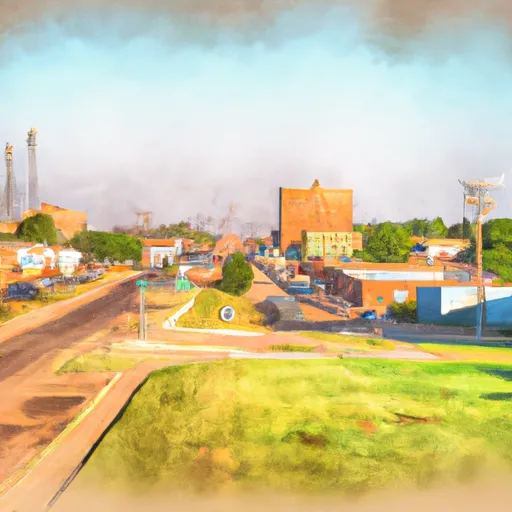-
 Snoflo Premium
Snoflo Premium
Get unlimited access to all our content
With no Ad interruptions! - Start Your Free Trial Login with existing account
Greenfield
Eden Index
Climate
8.3
•
Recreation
•
Community
•
Safeguard
3.3/10

Greenfield is a small town in central Oklahoma with a predominantly sunny and humid climate. Summers are hot, with average daytime temperatures in the mid to high 90s, while winters are relatively mild with average daytime temperatures ranging from the low 40s to low 50s. The area is primarily agricultural and is located in the North Canadian River watershed. Outdoor recreation opportunities in Greenfield include fishing, boating, and camping at nearby Canton Lake, as well as hiking and picnicking at Roman Nose State Park. The town is surrounded by rolling hills and prairies, making it an ideal location for outdoor enthusiasts.
What is the Eden Index?
The Snoflo Eden Index serves as a comprehensive rating system for regions, evaluating their desirability through a holistic assessment of climate health, outdoor recreation opportunities, and natural disaster risk, acknowledging the profound impact of these factors on livability and well-being.
Climate Health Indicator (CHI): 8.3
Greenfield receives approximately
755mm of rain per year,
with humidity levels near 81%
and air temperatures averaging around
16°C.
Greenfield has a plant hardyness factor of
7, meaning
plants and agriculture in this region tend to thrive during the non-winter months.
By considering the ideal temperature range, reliable water supplies, clean air, and stable seasonal rain or snowpacks, the Climate Health Indicator (CHI) underscores the significance of a healthy climate as the foundation for quality living.
A healthy climate is paramount for ensuring a high quality of life and livability in a region, fostering both physical well-being and environmental harmony. This can be characterized by ideal temperatures, reliable access to water supplies, clean air, and consistent seasonal rain or snowpacks.
Weather Forecast
Streamflow Conditions
Lower North Canadian
Area Rivers
Lower North Canadian
Snowpack Depths
Lower North Canadian
Reservoir Storage Capacity
Lower North Canadian
Groundwater Levels
Recreational Opportunity Index (ROI):
The Recreational Opportunity Index (ROI) recognizes the value of outdoor recreational options, such as parks, hiking trails, camping sites, and fishing spots, while acknowledging that climate plays a pivotal role in ensuring the comfort and consistency of these experiences.
Access to outdoor recreational opportunities, encompassing activities such as parks, hiking, camping, and fishing, is crucial for overall well-being, and the climate plays a pivotal role in enabling and enhancing these experiences, ensuring that individuals can engage in nature-based activities comfortably and consistently.
Camping Areas
| Campground | Campsites | Reservations | Toilets | Showers | Elevation |
|---|---|---|---|---|---|
| Fort Cobb - Area 3 | None | 1,378 ft | |||
| Fort Cobb - Area 5 | None | 1,380 ft | |||
| Lake Elmer Thomas Military - Fort Sill | None | 1,394 ft | |||
| Robinsons Landing - Lake Lawtonka | None | 1,355 ft | |||
| Fort Cobb - Area 2 | None | 1,360 ft | |||
| East Side - Lake Lawtonka | 35 | 1,365 ft | |||
| Edgewater Park - Lawton | None | 1,246 ft | |||
| Collier Landing City | None | 1,241 ft | |||
| Medicine Creek RV Military - Fort Sill | None | 1,138 ft | |||
| Randlett Park | None | 1,192 ft |
Nearby Fishing
Nearby Ski Areas
Catastrophe Safeguard Index (CSI):
The Catastrophe Safeguard Index (CSI) recognizes that natural disaster risk, encompassing floods, fires, hurricanes, and tornadoes, can drastically affect safety and the overall appeal of an area.
The level of natural disaster risk in a region significantly affects safety and the overall livability, with climate change amplifying these risks by potentially increasing the frequency and intensity of events like floods, fires, hurricanes, and tornadoes, thereby posing substantial challenges to community resilience and well-being.
Community Resilience Indicator (CRI):
The Community Resilience Indicator (CRI) recognizes that education, healthcare, and socioeconomics are crucial to the well-being of a region. The CRI acknowledges the profound impact of these elements on residents' overall quality of life. By evaluating educational resources, healthcare accessibility, and economic inclusivity, the index captures the essential aspects that contribute to a thriving community, fostering resident satisfaction, equity, and social cohesion.

